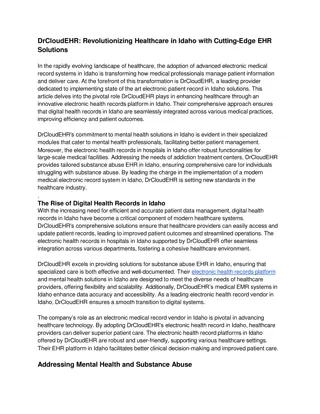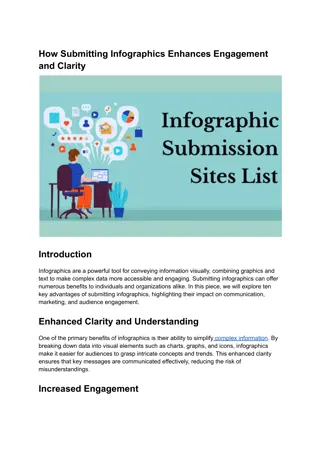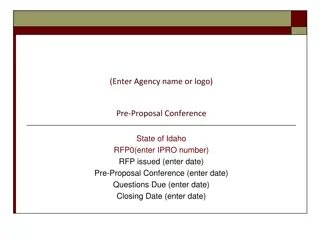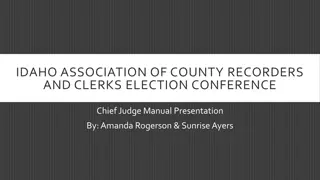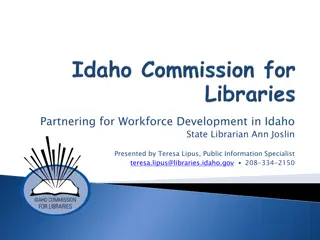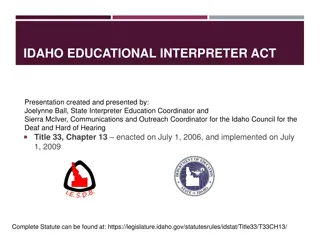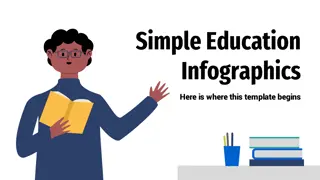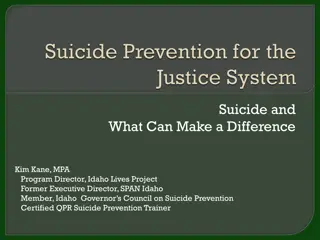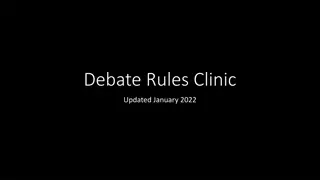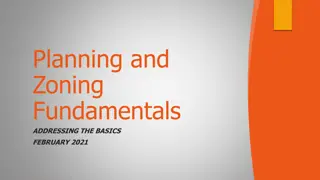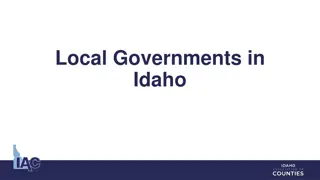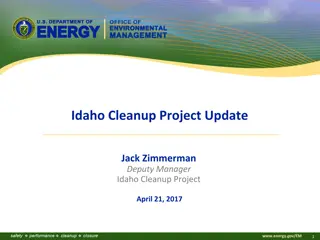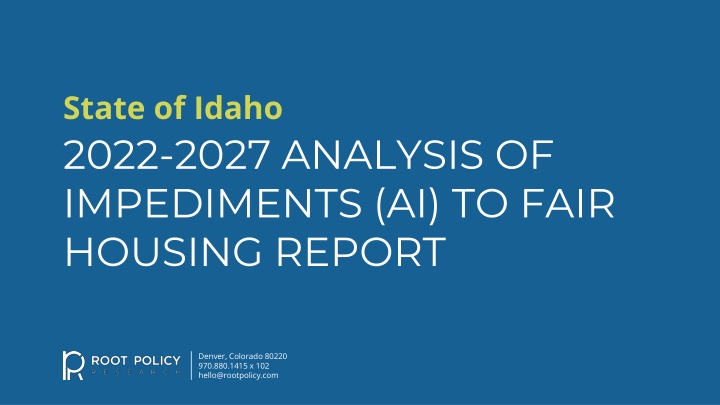
Analysis of Impediments to Fair Housing in Idaho 2022-2027
"Discover the housing needs in Idaho, examine economic changes impacting residents, and address barriers to housing choice and economic opportunity. Stakeholders prioritize affordable rentals, housing diversity, and supportive services. Engage with various resident groups to identify challenges and findings."
Download Presentation

Please find below an Image/Link to download the presentation.
The content on the website is provided AS IS for your information and personal use only. It may not be sold, licensed, or shared on other websites without obtaining consent from the author. If you encounter any issues during the download, it is possible that the publisher has removed the file from their server.
You are allowed to download the files provided on this website for personal or commercial use, subject to the condition that they are used lawfully. All files are the property of their respective owners.
The content on the website is provided AS IS for your information and personal use only. It may not be sold, licensed, or shared on other websites without obtaining consent from the author.
E N D
Presentation Transcript
State of Idaho 2022-2027 ANALYSIS OF IMPEDIMENTS (AI) TO FAIR HOUSING REPORT Denver, Colorado 80220 970.880.1415 x 102 hello@rootpolicy.com
Analysis of Impediments (AI) components Identify the state s greatest housing needs and how these have changed during the past five years; Examine how the state s economy has changed and what those changes mean for Idahoans economic stability Pinpoint the resident groups with the greatest housing needs Identify private sector actions and public sector regulations that interfere with housing choice Develop a plan for responding to barriers in housing choice and economic opportunity
Data Dashboard The key data elements of this study can be easily accessed online, at this link: https://reports.myside walk.com/209b1e773e
STAKEHOLDERS TOP RANKED NEEDS - Affordable rentals near employment centers - Preservation of low cost, market rate affordable housing - More diversity in housing types and price points - Affordable, integrated housing for residents needing supportive services - Affordable rental housing near strong schools Stakeholder Survey Housing Challenges Rating Scale - Affordable housing for people with disabilities leaving institutional settings - Affordable rental housing near transportation - Affordable child care Source: Root Policy Research
Resident Engagement Virtual focus groups were held with: Advocates in the disability community; Advocates in and for the refugee community; Low income households and households experiencing homelessness; Hispanic residents; Advocates for racial inclusion; and Advocates for sexual orientation and gender identity inclusion
DEMOGRAPHIC CHANGES HAVE BEEN MODEST Population Change, Idaho Counties, 2000-2020 - The State of Idaho s population has almost doubled since 1990. - The state s resident base has become slightly more diverse racially and ethnically. However, the strongest growth in numbers has remained in White, non- Hispanic residents. - Residents in Idaho are aging; 14% of Idahoans report having a disabling condition. Source: Root Policy Research
ECONOMIC GROWTH HAS BEEN ROBUST AND COULD BENEFIT MORE IDAHOANS Job Growth and Decline, State of Idaho, 2013-2019 - Over the last 20 years, the state s economic growth, as measured by GDP, has been consistently strong (62% growth). - The state s economic expansion created many new jobs but mostly in lower-paying industries. - Low-wage jobs dominate Idaho s economic landscape. Source: Root Policy Research
ECONOMIC GROWTH HAS BEEN ROBUST AND COULD BENEFIT MORE IDAHOANS Cost Burden by Industry, State of Idaho, 2019 - Idaho s economic growth has led to a significant drop in poverty from 15.6% in 2014 to 11.2% in 2019. - The state s economic growth strengthening has not benefitted residents equally particularly for low income residents and residents with disabilities. - The industries where jobs are growing the fastest are those where housing cost burden is the highest . Source: Root Policy Research
HOUSING NEEDS PERSIST AND DISPROPORTIONATELY AFFECT PERSONS WITH DISABILITIES, RACIAL/ETHNIC MINORITY HOUSEHOLDS - Around 6% of Idaho s population has an ambulatory disability but less than 1% of the housing stock is estimated to be accessible. - Idahoans with a disability are more likely to live in housing that is in substandard condition, live in overcrowded housing, and face cost burden than those without disabilities. - African American and Native American homeowners face the highest rates of housing cost burden among homeowners in the state. Overcrowded Households by Race and Ethnicity, State of Idaho, 2019 Source: Root Policy Research
HOUSING NEEDS PERSIST AND DISPROPORTIONATELY AFFECT PERSONS WITH DISABILITIES, RACIAL/ETHNIC MINORITY HOUSEHOLDS - African American, Native American, and Hispanic households are two to four times more likely to live in overcrowded conditions than Idahoans overall. - 71% of White Idahoans own their homes compared to just 38% of African American households and about half of Native American and Hispanic households. - African American, Native American and Hispanic applicants for mortgage loans are denied loans 1.5 to 2 times greater than White, non-Hispanic applicants. Denial Rates by Race and Ethnicity & Income, State of Idaho, 2019 Source: Root Policy Research
HOUSING INSTABILITY COULD THREATEN FUTURE ECONOMIC GROWTH - The state has a relatively low labor force participation rate by women with young children. - Foreign-born workers are more likely to participate in the workforce than U.S. born workers. They also face significant housing challenges. - Overall, 25% of the state s jobs pay less than what is needed to afford basic housing. - The inability of employers to attract and retain workers threatens continued economic growth. Mothers Labor Force Participation Rates by County, 2019 Source: Root Policy Research
IDAHO'S REGULATORY STANCE ON LAWS AFFECTING AFFORDABLE HOUSING COULD BE IMPROVED TO FACILITATE HOUSING CHOICE - Idaho statutes (regulations governing land use, zoning, housing type and placement) continue to be silent in many areas that affect residential development; local governments primarily adopt these regulations. Housing Units Built Before 1980 by County, 2019 - While this approach allows for flexibility, it leaves local governments vulnerable to fair housing challenges. Additionally, Idaho s hands off stance does little to encourage much- needed housing supply. Source: Root Policy Research
COSTS OF HOUSING INSTABILITY Cost burden exists when households pay > 30% of their incomes for housing. This reduces their inability to pay for other households goods and invest in local economies. Reducing housing cost burden to zero would have the potential to free up $971 million in household spending annually that could be invested within Idaho communities. Source: Root Policy Research
COSTS OF HOUSING INSTABILITY Sources: Smith, Stanley K., Stefan Rayer, and Eleanor A. Smith. "Aging and disability: Implications for the housing industry and housing policy in the United States." Journal of the American Planning Association ; Root Policy Research.
MOVING FORWARD The state is in a sound position economically; Infusion of federal funding presents a unique opportunity to invest in and leverage innovative and effective housing solutions; There is a growing concern among stakeholders that housing challenges could impair long term economic growth; and Needs are at a more manageable level with the state s overall decline in poverty.
ADDRESS CONSEQUENCES OF LOW WAGES AND GAPS IN HOUSING COSTS
- Continue to allocate CDBG to job creation and skill development activities in rural areas - Communicate to foundations and other private sector partners the need for resources to improve access to affordable child care and ECE programs, especially for low-income and weekend/shift workers - Continue to fund child care centers with CDBG and bolster awareness - Continue to utilize and promote existing resources (WeCAN Peer Learning Network) to educate rural communities about innovative and effective responses to housing challenges Addressing economic opportunity barriers: IHFA and Commerce Five-Year Action Items
Addressing economic opportunity barriers: Stakeholder Recommend- ations - Explore funding opportunities to expand transportation options, including shared shuttle programs, that serve low-income workers and persons with disabilities - As opportunities allow, prioritize federal funding to expand public transportation services to include later and weekend transit hours on existing routes and where low-income workers need service the most
NARROW DISPARITIES IN HOUSING CHALLENGES AND CHOICE
Expanding housing options and choice: IHFA and Commerce Five-Year Action Items - Continue preferences for housing persons with disabilities, elderly, and extremely low-income households in state housing grant awards - Continue to include a preference for LIHTC applications that target very low- and extremely low-income households for permanent supportive housing to persons with disabilities and/or persons experiencing homelessness - Continue to fund credit counseling and homeownership readiness programs and include bilingual options and affirmative marketing
- Continue to require that communities receiving housing awards, including tax credits, are taking meaningful actions to reduce fair housing discrimination and housing access barriers - Continue to provide extra scoring points to CDBG grant applicants that have local fair housing protections equivalent to federal protections - Explore a program that pairs good tenant education with 1stand last month s rent and security deposit subsidies to landlords who accept voucher holders, tenants perceived as high risk, or those who do not meet traditional application requirements Expanding housing options and choice: IHFA and Commerce Five-Year Action Items
Expanding housing options and choice: IHFA and Commerce Five-Year Action Items - Continue and consider expanding scoring preferences in the QAP for LIHTC developments that prioritize accessibility, visitability, and adaptable features in design - Continue scoring preferences for ADA improvements funded by CDBG and ensure grantees have updated ADA transition plans - Consider providing additional HOME funds to projects that exceed fair housing accessibility requirements in multifamily construction to cover additional costs
Expanding housing options and choice: Stakeholder Recommend- ations - Consider a program like Colorado s new 1271 grants that support planning and land use studies, innovative housing solutions, and infrastructure grants to support affordable housing - Support state efforts to establish a recurring source of funding for affordable housing development and preservation
Expanding housing options and choice: Stakeholder Recommend- ations - Implement a new fund or pool existing resources for: 1) Home modifications to enhance accessibility; 2) Incentivize newly built housing that is visitable and adaptable; and 3) Assist groups homes with financial stability and viability. - Consider a program like Colorado s new 1271 grants and federal funds to increase housing density allowed around transportation corridors to expand accessibility around transit hubs
ENHANCE AFFORDABLE HOUSING PRODUCTION
Enhancing housing production: IHFA and Commerce Five-Year Action Items - Continue education and outreach activities to local governments on economic opportunities created by housing affordability and equity, and explore best practices in land use and zoning to encourage diverse housing types and price points
Enhancing housing production: Stakeholder Recommend- ations - Support legislative efforts or allow by-right affordable housing development and gentle density bonuses for affordable developments as long as they are compatible with the local government s comprehensive plan - Support legislative efforts that expand local governments ability to raise funds to expand housing choice
IMPROVE FAIR HOUSING KNOWLEDGE AND AWARENESS
- Continue to require that CDBG awardees take efforts to support AFFH - Continue to prioritize investments in fair housing education and outreach - Prioritize fair housing law education for landlords, property managers, local government staff, and elected officials, and neighborhood associations - Update and expand the AI Data Dashboard - Continue to provide state leadership with information on the benefits of a substantially equivalent state fair housing act Improving knowledge and awareness: IHFA and Commerce Five-Year Action Items
Improving knowledge and awareness: Stakeholder Recommend- ations - Consider pursuing funding for a management consultant or mediator to work through tensions between fair housing organizations, housing providers (landlords, business owners, affordable housing providers), and local governments, with the goal to establish best practices

